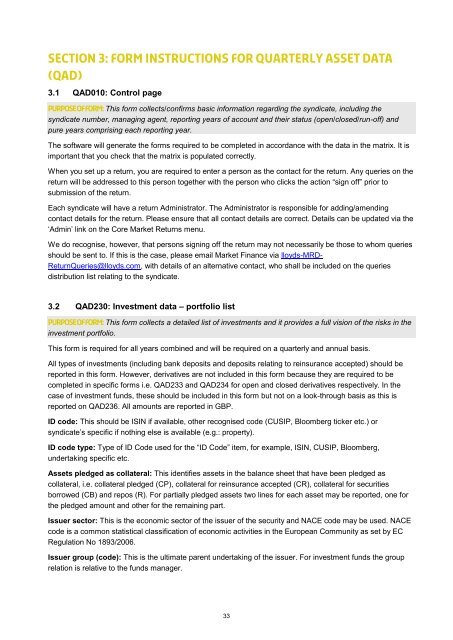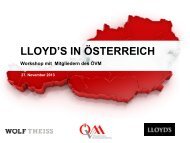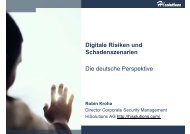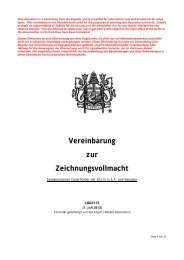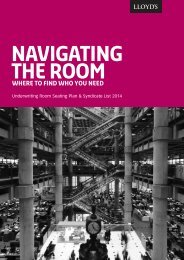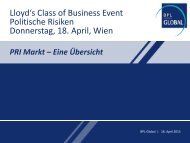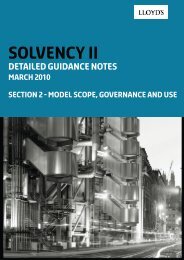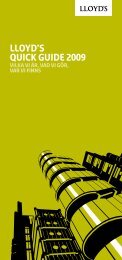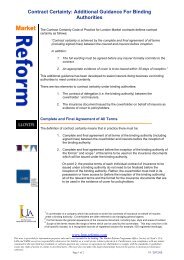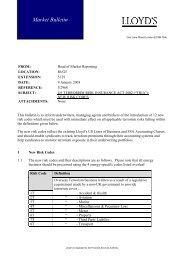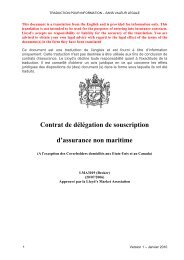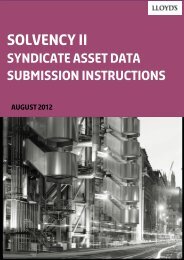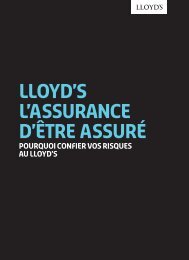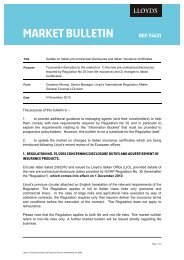Create successful ePaper yourself
Turn your PDF publications into a flip-book with our unique Google optimized e-Paper software.
Section 3: form instructions for Quarterly Asset Data<br />
(QAD)<br />
3.1 QAD010: Control page<br />
Purpose of form: This form collects/confirms basic information regarding the syndicate, including the<br />
syndicate number, managing agent, reporting years of account and their status (open/closed/run-off) and<br />
pure years comprising each reporting year.<br />
The software will generate the forms required to be completed in accordance with the data in the matrix. It is<br />
important that you check that the matrix is populated correctly.<br />
When you set up a return, you are required to enter a person as the contact for the return. Any queries on the<br />
return will be addressed to this person together with the person who clicks the action “sign off” prior to<br />
submission of the return.<br />
Each syndicate will have a return Administrator. The Administrator is responsible for adding/amending<br />
contact details for the return. Please ensure that all contact details are correct. Details can be updated via the<br />
‘Admin’ link on the Core Market Returns menu.<br />
We do recognise, however, that persons signing off the return may not necessarily be those to whom queries<br />
should be sent to. If this is the case, please email Market Finance via lloyds-MRD-<br />
ReturnQueries@lloyds.com, with details of an alternative contact, who shall be included on the queries<br />
distribution list relating to the syndicate.<br />
3.2 QAD230: Investment data – portfolio list<br />
Purpose of form: This form collects a detailed list of investments and it provides a full vision of the risks in the<br />
investment portfolio.<br />
This form is required for all years combined and will be required on a quarterly and annual basis.<br />
All types of investments (including bank deposits and deposits relating to reinsurance accepted) should be<br />
reported in this form. However, derivatives are not included in this form because they are required to be<br />
completed in specific forms i.e. QAD233 and QAD234 for open and closed derivatives respectively. In the<br />
case of investment funds, these should be included in this form but not on a look-through basis as this is<br />
reported on QAD236. All amounts are reported in GBP.<br />
ID code: This should be ISIN if available, other recognised code (CUSIP, Bloomberg ticker etc.) or<br />
syndicate’s specific if nothing else is available (e.g.: property).<br />
ID code type: Type of ID Code used for the “ID Code” item, for example, ISIN, CUSIP, Bloomberg,<br />
undertaking specific etc.<br />
Assets pledged as collateral: This identifies assets in the balance sheet that have been pledged as<br />
collateral, i.e. collateral pledged (CP), collateral for reinsurance accepted (CR), collateral for securities<br />
borrowed (CB) and repos (R). For partially pledged assets two lines for each asset may be reported, one for<br />
the pledged amount and other for the remaining part.<br />
Issuer sector: This is the economic sector of the issuer of the security and NACE code may be used. NACE<br />
code is a common statistical classification of economic activities in the European Community as set by EC<br />
Regulation No 1893/2006.<br />
Issuer group (code): This is the ultimate parent undertaking of the issuer. For investment funds the group<br />
relation is relative to the funds manager.<br />
33


